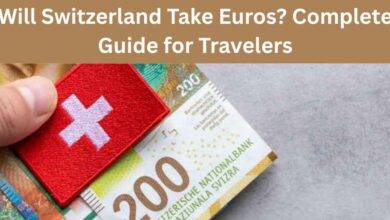Traffic Rules in Switzerland – Guide for Safe & Legal Driving

Switzerland is renowned for its well-maintained roads, disciplined drivers, and strict enforcement of traffic laws. If you’re planning to drive in Switzerland for the first time, it’s crucial to understand the country’s traffic rules and road signs to ensure a safe and enjoyable journey.
This guide covers everything you need to know for a smooth driving experience in Switzerland.
General Driving Rules:
Switzerland’s strict driving regulations are designed to keep roads safe for everyone. Whether you’re exploring mountain passes or navigating city streets, knowing these key rules will help you drive confidently and avoid fines.
- Drive on the right: Vehicles travel on the right-hand side. Overtaking is done on the left.
- Seat belts are mandatory: All passengers, front and rear, must wear seat belts at all times.
- Speed limits:
- 120 km/h on motorways (Autobahn)
- 100 km/h on expressways
- 80 km/h on rural roads
- 50 km/h in urban areas
- 30 km/h or lower in residential zones
- No right turn on red: Unlike in some countries, turning right at a red light is prohibited unless indicated otherwise.
- Daytime headlights: Drivers must keep headlights on even during daylight hours, regardless of weather conditions.
- Mobile phones: Using a handheld mobile phone while driving is strictly forbidden. Only hands-free devices are allowed.
- Alcohol limit: The legal blood alcohol limit is 0.05% (lowered to 0.01% for new drivers). Enforcement is strict, and penalties for driving under the influence are severe.
- Priority from the right: Unless otherwise marked, vehicles approaching from the right have priority at intersections.
- Pedestrian crossings: Pedestrians have the right of way at zebra crossings. Drivers must stop if someone intends to cross.
Important Traffic Signs:
Swiss roads are well-marked, but unfamiliar signs can be confusing. Understanding these essential signs will help you navigate safely:
- Blue circular signs: Indicate mandatory directions or actions, such as turning left or right.
- Red circular signs: Indicate prohibitions, such as “no entry” or restrictions for certain vehicles.
- Red circle with a white center: Means “no entry for vehicles.”
- Red circle with car and motorbike symbols: Indicates “no entry for cars and motorbikes.”
- Yellow diamond: Marks a priority road. Vehicles on this road have the right of way.
- Triangle with a red border: Signals “give way.”
- Green signs: Mark motorways.
- Blue signs: Indicate main roads.
- Speed limit signs: Displayed inside red circles.
- Red-bordered circle with a black arrow crossed by a red slash: Prohibits turns in the indicated direction.
- One-way street signs:
- Blue arrow signals mandatory one-way direction.
- Red circle with a horizontal white bar means “no entry” from that direction.
- Parking signs:
- Blue circle with a red border and a single red slash indicates no parking.
- Blue circle with a red border and an X indicates no stopping.
Check Also: Meet Tobias from Zurich – Swiss Local Travel Tips
Parking Regulations:
Parking is tightly regulated across Switzerland. Understanding zone colors and time limits is essential to avoid fines:
- White zones: Paid parking areas. Pay at ticket machines or via parking apps.
- Blue zones: Free parking for a limited time. Use a blue parking disc, available at petrol stations.
- Yellow zones: Reserved for private use. Do not park here.
Parking fines range from CHF 40 to CHF 120 for overstaying time limits or illegal parking. In serious cases, your vehicle may be towed.
Road Tolls and Vignette:
To drive on Swiss motorways (Autobahn), you must purchase a vignette, which serves as your toll sticker:
- Cost: CHF 40
- Validity: Calendar year (from December of the preceding year until January of the following year)
- Available at petrol stations, post offices, border crossings, and online as a digital vignette linked to your license plate
Driving without a vignette results in a fine of CHF 200, plus the cost of purchasing one.
Winter Driving Rules:
Swiss winters can bring challenging driving conditions, especially in mountainous regions. If you’re visiting between November and April, keep these tips in mind:
- Winter tires recommended: While not mandatory, they’re strongly advised for better grip and shorter braking distances on snow and ice.
- Snow chains: Required on specific roads during heavy snowfall, as indicated by signs. Some mountain areas may enforce snow chain requirements even if you have winter tires.
- Mountain driving: On narrow mountain roads, uphill traffic has priority over downhill traffic to help vehicles maintain momentum.
- Road closures: Many high mountain passes close during winter. Check road and weather conditions before traveling, especially in remote areas.
- Black ice risk: Be vigilant for black ice, particularly on bridges, shaded sections, and during early mornings. Avoid sudden maneuvers to maintain vehicle control.
Public Transport Lanes and Buses:
Switzerland has an excellent public transport system. When driving, be mindful of how to share the road safely with buses and trams:
- Dedicated lanes: Marked with solid white or yellow lines and labeled “BUS” or with tram symbols. Private vehicles are not allowed in these lanes unless indicated.
- Tram stops: When trams stop to pick up or drop off passengers, vehicles must wait until it’s safe to proceed, especially in city centers where trams stop in traffic lanes.
- Trams have priority: Trams always have the right of way, even at intersections without traffic lights. Never block tram tracks.
- Buses pulling out: When a bus leaves a stop, drivers must allow it to merge back into traffic.
Emergency Numbers:
In case of an emergency while driving in Switzerland, these are the essential numbers to know:
- Police: 117
- Fire Brigade: 118
- Ambulance: 144
- Roadside Assistance: 140
- Rega (rescue helicopter): 1414
TCS (Touring Club Suisse) is the country’s largest roadside assistance service, offering breakdown help, towing, and travel support nationwide. Many rental car agencies partner with TCS for emergency services.
Final Thoughts:
Driving in Switzerland is an excellent way to explore the country’s diverse landscapes, from alpine passes to serene lakeside roads. By familiarising yourself with local traffic rules, speed limits, and parking regulations, you can avoid fines and enjoy a safe, stress-free journey.
Frequently Asked Questions:
Do I need a vignette (toll sticker) in Switzerland?
Yes. A vignette is required to drive on Swiss motorways and costs around CHF 40 per year.
Are headlights mandatory during the day?
Yes, dipped headlights (or daytime running lights) must be on at all times while driving.
Can I use my foreign driving licence in Switzerland?
Tourists can use their valid foreign licence for up to 12 months. Residents must exchange certain licences for a Swiss one within that time.



